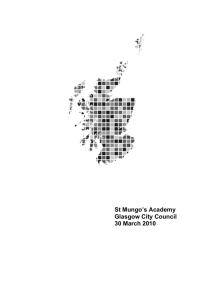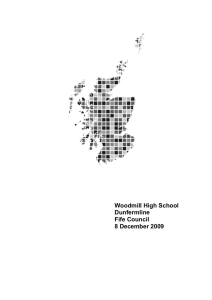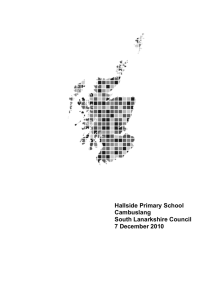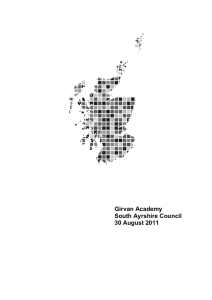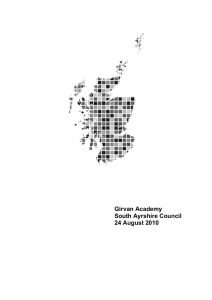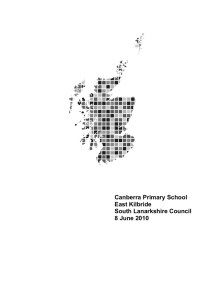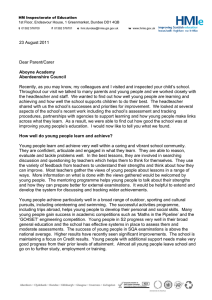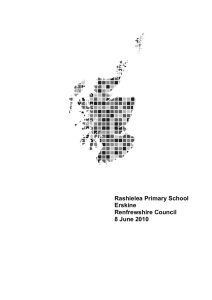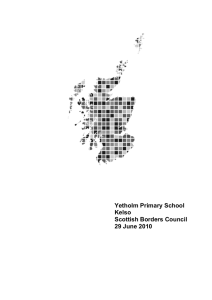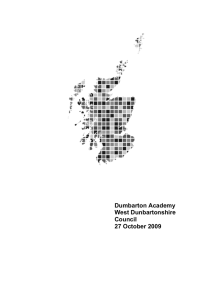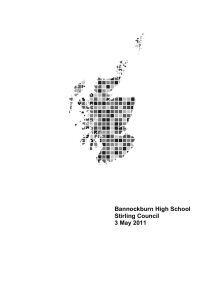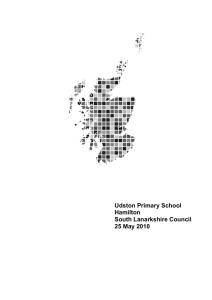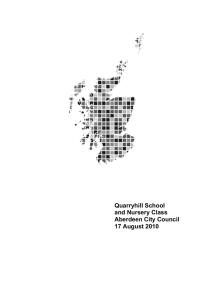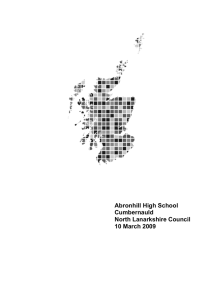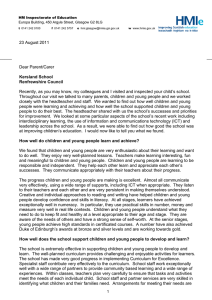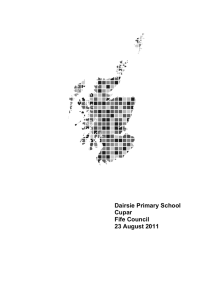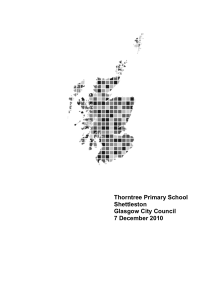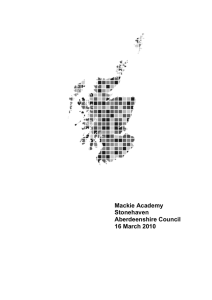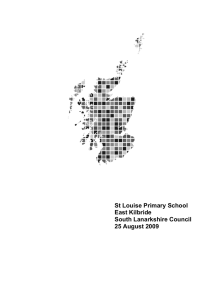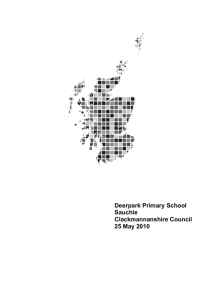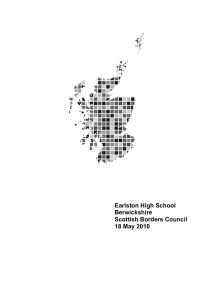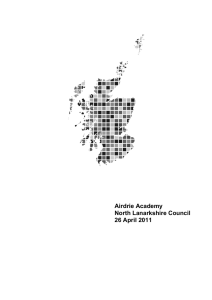St Mary’s Primary School Larkhall South Lanarkshire Council
advertisement
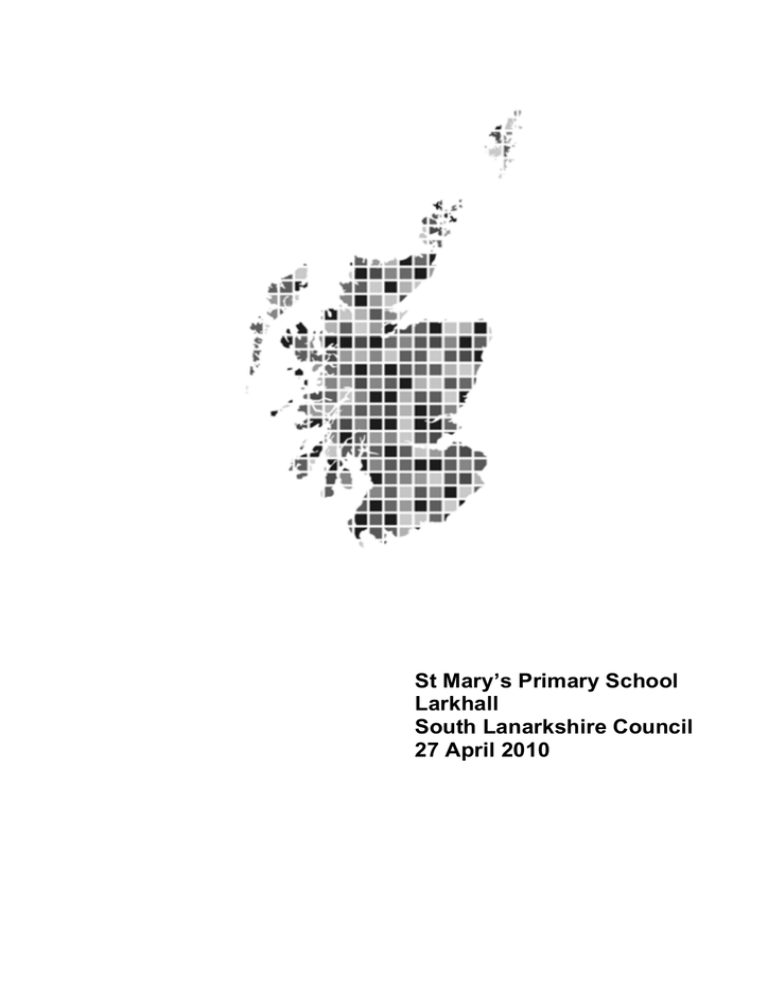
St Mary’s Primary School Larkhall South Lanarkshire Council 27 April 2010 We published a report on St Mary’s Primary School in March 2009. That report set out key strengths of the school and main points for action. This follow-through report is based on an inspection visit which was carried out in February 2010. It tells you about improvements since the original inspection in the quality of education which the school provides. It also comments on how the school is getting on with the main points for action. First we focus on changes in the core work of the school. We explain how the school has got better at helping children to learn and benefit from being at the school. Next we look at the key processes which enable this to happen, including the involvement of parents1. Our report also describes developments in the ‘ethos’ of the school, by which we mean how well children are cared for and how much is expected of them in all aspects of school life. Finally we comment on improvements in leadership to help the school achieve its aims. A copy of this report has been placed on the HMIE website www.hmie.gov.uk. Where applicable, you will also find analyses of questionnaire returns. 1 Throughout this report, the term ‘parents’ should be taken to include foster carers, residential care staff and carers who are relatives or friends. Contents 1. The school 2. Particular strengths of the school 3. How well do children learn and achieve? 4. How well do staff work with others to support children’s learning? 5. Are staff and children actively involved in improving their school community? 6. Does the school have high expectations of all children? 7. Does the school have a clear sense of direction? 8. What happens next? 1. The school St Mary’s Primary School serves the town of Larkhall and surrounding areas. 2. Particular strengths of the school • Well-behaved, confident and polite children. • Strong staff teamwork, with a clear focus on improving learning and teaching. • Approaches to promote children’s health and wellbeing. 1 3. How well do children learn and achieve? At all stages, children are more actively involved and engaged in their learning. They enjoy using games to support their learning in English language and mathematics. Children have more opportunities to learn from each other and work together in groups. Across the school, teachers are now clearer about what they expect children to learn. They share the purpose of lessons more effectively with children. The school has made a good start to involving children in planning their own learning. As a result, in mathematics children are increasingly aware of their strengths, progress and next steps in learning through better feedback and target setting. This approach now needs to be extended to other areas of the curriculum. Children are making more use of information and communications technology to develop their knowledge and understanding in a range of subjects. Teachers are providing a broader range of experiences to help children achieve more widely. Teachers have started to use the experiences and outcomes from Curriculum for Excellence in their planning. In environmental studies, teachers take greater account of children’s interests and prior learning to ensure learning experiences are more relevant for children. In English language and mathematics, teachers rely less on textbooks and are finding ways for children to learn in real-life contexts. They should now continue to develop children’s skills in literacy and numeracy across all subject areas. The level of difficulty of activities is matched appropriately to the needs of most children. The headteacher works more closely with teachers to monitor children’s progress and this is improving the pace of learning. The school now has better approaches for identifying and supporting the needs of potentially vulnerable children. Staff are aware of their responsibilities for children who need help with their learning. The targets within individualised educational programmes should be written in language that is appropriate to the age and stage of the child. 2 4. How well do staff work with others to support children’s learning? School staff continue to work well with professionals from outside agencies to support learning. They make effective use of outings and visitors to the school to make learning more interesting. Staff have benefited from visiting other local schools to observe good practice. Through personal learning planning, staff are getting better at involving parents in supporting their children’s learning. Parents now receive helpful information through a school website and monthly newsletters. The school does not, as yet, have a Parent Council or parent-teacher association. The school needs to explore further how it can involve parents more fully in school life. The school has suitable procedures for dealing with complaints. 5. Are staff and children actively involved in improving their school community? Children in the new eco committee have succeeded in promoting a litter free playground. The pupil council has been involved in the introduction of new suggestion boxes in every classroom and has enabled funds to be distributed to worthy causes. The school recognises the need for the pupil council to have more of a say, particularly in how to make learning better. All staff are committed to school improvement. They regularly review the work of the school and agree priorities for improvement. The headteacher visits classes to observe learning and teaching and provides helpful feedback to teachers. School staff use questionnaires to seek the views of children and parents on a few aspects of the school’s work. They do not yet do this systematically enough on a broad enough range of aspects of the school’s provision. 3 6. Does the school have high expectations of all children? Children are well behaved, polite and are proud of their school. They show respect for each other and staff. Their achievements both in and out of school are celebrated well through displays, assemblies and newsletters. Teachers effectively encourage children to work hard. The school’s emphasis on health promotion is improving children’s understanding of healthy lifestyles. 7. Does the school have a clear sense of direction? The headteacher is providing a clearer sense of direction which staff recognise and appreciate. She is effectively supported by the principal teacher who has led a number of improvements and provides valued support to teachers. Staff are willing to adopt leading roles in developing key aspects of the school. All staff are increasingly working well together to improve learning and teaching. Education authority staff have worked closely with teachers, leading and supporting improvements. Staff now have a better understanding of what needs to be done to improve. Children now develop leadership skills in a wider range of roles. These include becoming house captains and acting as eco committee or pupil council representatives. 8. What happens next? There is evidence of improvement since the original inspection. The school now performs better overall. The arrangements to meet learning needs and for evaluating the work of the school are now at a satisfactory or better level. The school, with support from the education authority, shows a capacity for further improvement. We will make no further visits in connection with the inspection report of March 2009. HM Inspector: Marie McAdam 27 April 2010 4 When we write reports, we use the following word scale so that our readers can see clearly what our judgments mean. excellent very good good means means means satisfactory weak unsatisfactory means means means outstanding, sector leading major strengths important strengths with some areas for improvement strengths just outweigh weaknesses important weaknesses major weaknesses If you would like to find out more about our inspections or get an electronic copy of this report, please go to www.hmie.gov.uk. Please contact us if you want to know how to get the report in a different format, for example, in a translation, or if you wish to comment about any aspect of our inspections. You can contact us at HMIEenquiries@hmie.gsi.gov.uk or write to us at BMCT, HM Inspectorate of Education, Denholm House, Almondvale Business Park, Almondvale Way, Livingston EH54 6GA. Text phone users can contact us on 01506 600 236. This is a service for deaf users. Please do not use this number for voice calls as the line will not connect you to a member of staff. You can find our complaints procedure on our website www.hmie.gov.uk or alternatively you can contact our Complaints Manager, at the address above or by telephoning 01506 600259. Crown Copyright 2010 HM Inspectorate of Education
